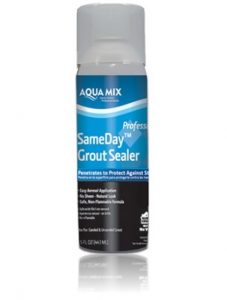Dealing With Grout
Tiles can add a splash of style to any room and, once installed, take very little looking after and will generally maintain the same aesthetic throughout the life of the tiles. There’s one thing that can put paid to this however; dirty and poorly maintained grout. Whilst grout is an essential part of any tiling project – it fills the spaces between tiles, provides a finished look, and forms a water-resistant seal – it’s also porous and susceptible to picking up dirt and mildew over time.
So, how do you avoid this? Well, you could spend hours regularly cleaning each and every single grout line with a toothbrush or painting them over (you may have seen ‘Grout Pen’ products on the market specifically designed for this purpose), or you could remove the offending grout completely and totally re-grout. Both those options can be both costly and time-consuming though, so we’re we’re going to explore some other effective ways of how to maintain and clean grout that focus on preventing dirt and damage rather than remedying it once it’s happened.
Why Does Grout Get Dirty?
Whilst the purpose of grout is ostensibly to form a water-tight seal between the tiles and prevent water from getting behind them, grout itself is porous and is not actually 100% waterproof, more like very water-resistant. This is because grout is generally cement-based (although there are polymer plastic grouts such as epoxy resin available), meaning that the compound itself has millions of minute holes throughout it, even when fully cured. Liquid and air is able to pass through these holes – although not to the extent that it causes damage to your tiles – and dirt often contained within water the grout is exposed to can also be absorbed, making the grout’s superficial appearance grubby overt time.

Can Grout Be Sealed?
The short answer is ‘yes’. However, there are a couple of ways that you can do it. If the tiles you have installed are natural stone then there’s a good chance that the tiles will need sealing post-installation. If this is the case then there’s no need to seal your grout separately as the sealer you use for the tiles will also do the job for the grout. Should you need to seal only your grout however then we recommend using a dedicated grout sealer such as Aquamix Grout Sealer. Grout sealers of this type do not affect the grout colouring and are pretty simple to apply – just spray the solution directly onto the grout joints and then wait for it to dry before subjecting the treated area to direct water.

How Do I Stop Grout Being Affected By Mould & Mildew?
Most modern grout such as Mapei Ultracolour contain anti-bacterial agents that act to prevent mould and mildew before it gets a foothold, so you should always make sure that you choose a grout that is both suitable for your project and has anti-mould properties where possible. If this is not possible, you should look to seal the grout using a product like that described in the section above. Even if you do opt to use Anti-Mould Grout for your project then there’s no harm in also sealing it afterwards to bolster its mould resistance. Mould and mildew is formed from spores carried by air current that land on surfaces and grow if there is sufficient moisture, and as grout is porous and absorbs water to some extent, it’s always a good idea to limit the grout’s exposure to water where possible to prevent mould and mildew growing.

What’s The Best Way To Clean Grout?
Cementitious grout is porous (although not to a degree that will allow water damage) and as such, is susceptible to stain absorption. Sealing the grout in the ways described earlier in this article will provide that extra layer of protection but at some point, it’s still likely that your grout joints will require cleaning. To do this, we’d again recommend regularly using a specialist product such as Aquamix Grout Deep Clean. Products of this kind are formulated to prevent absorption of stains by grout and because they’re often water-based, won’t harm your tiles in the process. If you don’t want to invest in a dedicated grout cleaning product then you can always create your own using baking soda and water. Simply add one part water to two parts baking soda and mix into a paste, rub it on the stained grout, let it sit overnight, then scrub off the following day with a stiff nylon brush.
 Do ‘Grout Pens’ Really Work?
Do ‘Grout Pens’ Really Work?
You may well have seen myriad of ‘grout pen’ type products on the market that claim to rejuvenate your grout with one, quick application. Whilst these kind of grout treatments are great for a quick touch up and will make your grout joints look better superficially, the quality varies widely and the longevity of the finish is always suspect. In using these products you are effectively painting the grout and that means that, just like paint you’d use on the wall, it’ll fade and need constant reapplication to maintain any kind of pleasing finish. If you do want to go down the grout pen route then we’d recommend Fuga Fresca from leading grout and adhesives manufacturer Mapei. This particular product is a water-soluble polymer paint with an acrylic resin base that, thanks to its specific characteristics and its excellent covering power, allows you to obtain uniform colour and coverage across your grout joints.
Of course there’s one other trick that you can use from the outset and which will ‘disguise’ any discolouring in your grout; use darker shades instead of white! It’s a bit of a cheat and still doesn’t prevent you from having to clean your grout, but dark grout is very fashionable right now and is a little less maintenance intensive. Check out our grout range to see all the colours we have available.
Recommended Posts
Match Your Backsplash To Your Countertop
The perfect backsplash and countertop duo will change the entire look and feel of your kitchen. But ...
Read MoreThe Art of Mosaic Tiles
A walkway, patio, kitchen or bathroom floor, or any other surface with mosaic tile can look sophisti...
Read More4 Things To Think About When Choosing Outdoor Tiles
Outdoor projects can be fun and fulfilling, especially when they make our homes look spectacular. It...
Read MoreRenovating Your Bathroom
The bathroom is the place where you step in first when you wake up in the morning. After a tiring da...
Read More


